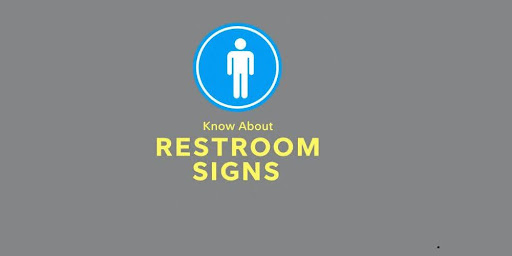Introduction
Choosing the right restroom signs is more important than you might think. These signs aren’t just about labeling doors; they’re about compliance, accessibility, and ensuring a seamless experience for everyone who uses your facilities. Ready to dive in and learn everything you need to know about these essential markers? Let’s go!
Understanding Restroom Sign Requirements
Definition and Importance
Restroom signs guide people to facilities and denote key features like gender specification and accessibility. Their importance cannot be overstated as they ensure clear communication and compliance with legal standards.
Historical Background
Evolution of Restroom Signs
Restroom signs have evolved significantly over the years. From the early simple, handwritten signs to modern-day ADA-compliant signage, the journey reflects societal changes, technological advances, and increased focus on inclusivity.
Types of Restroom Signs
Gender-Specific Signs
The classic male/female restroom signs have been around for ages. These typically use universally recognized pictograms alongside text identifiers. They’re straightforward and easily understood by most people.
Gender-Neutral Options
With an increasing focus on inclusivity, gender-neutral signs have become more common. These signs might simply say “Restroom” or “All-Gender Restroom” and include pictograms that signify universal access.
Specialty Signs
Specialty restroom signs, such as those indicating family restrooms or accessible facilities, are designed to address specific needs. These often include additional symbols like baby changing tables or wheelchair access.
Design Considerations
Visual Elements
Clarity is key. High contrast between text and background, clear typography, and recognizable symbols are essential. Who wants to squint or guess what a sign says, right?
Size Requirements
Bigger isn’t always better, but it needs to be big enough. A general rule is that characters should be at least 5/8 inch high to ensure readability from a distance.
Color Schemes
Color schemes should offer high contrast, making the text stand out. Common combinations include white on dark blue, black on white, and white on black.
Symbols and Icons
Symbols and icons need to be universally recognized. Think of the classic stick figures for men and women or the universally recognized wheelchair icon for accessible restrooms.
Compliance Guidelines
ADA Requirements
The Americans with Disabilities Act (ADA) requires that restroom signs include tactile characters and Braille, and be mounted at specific heights. Ensuring accessibility means following these guidelines to the letter.
Building Codes
Beyond ADA, you need to consider local building codes. These might dictate additional requirements for size, placement, and style that could vary by location.
International Standards
If you’re managing an international facility or looking at international guidelines, adherence to standards like those from ISO ensures global usability and consistency.
Material Options
Plastic Signs
Plastic signs are cost-effective, durable, and easy to clean. They come in various finishes and are a popular choice for all types of facilities.
Metal Signs
Metal signs offer a premium look and extended durability. They’re often vandal-resistant and suitable for both indoor and outdoor use, though they come at a higher cost.
Acrylic Signs
Acrylic signs provide a modern, sleek look and are highly customizable. They’re durable and moderately priced, making them a versatile option for many facilities.
Installation Guidelines
Mounting Height
Restroom signs should be mounted so that the center line of the sign is 60 inches from the floor. This ensures that they’re at an appropriate height for both visibility and accessibility.
Location Guidelines
Place signs adjacent to the door, on the latch side. Make sure there’s at least 18 inches of clear floor space leading up to the sign to make them unobstructed and easy to spot.
Lighting Considerations
Good lighting is crucial. Ensure restroom signs are well-lit to be visible at all times, especially in dimly-lit corridors or during nighttime.
Maintenance
Regular Upkeep
Regular cleaning and routine inspections are necessary to keep signs legible and compliant. This prevents wear and ensures they remain effective.
Common Issues
Be on the lookout for common issues like fading, vandalism, and wear and tear. Address these promptly to maintain the integrity and appearance of your signs.
Cost Considerations
Initial Costs
Initial costs vary depending on the material and customization level. Plastic is generally more affordable, while metal and acrylic can be pricier due to their durability and aesthetic appeal.
Long-term Value
Investing in high-quality signs can save money in the long run. Durable materials need fewer replacements and maintain their appearance over time.
Future Trends
Technological Advances
We’re seeing signs with integrated technology such as digital displays and smart sensors to provide real-time information about restroom availability and occupancy.
Changing Regulations
Keep an eye on evolving standards and inclusivity trends. Regulatory changes might require updates or replacements to ensure continued compliance.
Conclusion
Restroom signs are a small but mighty part of facility management. They ensure safety, compliance, and accessibility for all users. By understanding the different types, design considerations, and compliance guidelines, you can make informed decisions that benefit everyone.
FAQs
Q: How often should restroom signs be inspected?
A: Conduct visual inspections monthly and comprehensive checks quarterly to ensure they remain compliant and effective.
Q: Can I create custom restroom signs?
A: Yes, custom designs are possible, but they must meet all ADA and local regulatory requirements, including size, contrast, and tactile features.
Q: What’s the required height for mounting restroom signs?
A: The center line of the sign should be 60 inches from the floor to ensure accessibility.
Q: Are illuminated restroom signs necessary?
A: While not always required, adequate lighting around signs is essential for visibility, especially in low-light environments.
Q: Do all restroom signs need to include Braille?
A: Public facilities must include Braille on their signs per ADA requirements, though private residences are typically exempt.



































